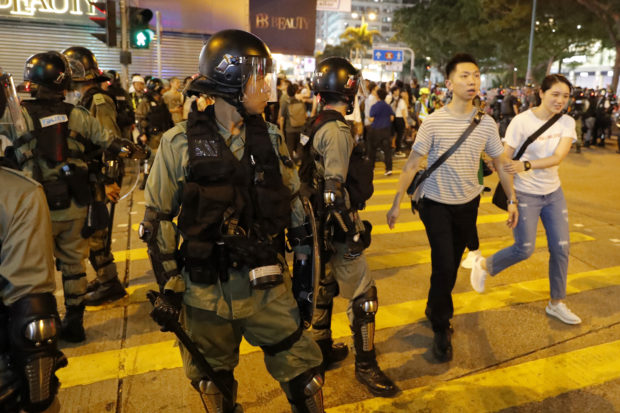As protesters scatter, Hong Kong residents take their place
HONG KONG – After the protesters evacuated, the residents took their place.
In one Hong Kong neighborhood on Saturday, riot police fired multiple rounds of tear gas, prompting demonstrators to flee after they started a fire outside a police station and threw eggs at its exterior. But while the pro-democracy protesters left to occupy yet another district, the residents who were watching from the sidelines descended by the hundreds.

Residents past by police in riot gear during street protests in Hong Kong on Saturday, Aug. 10, 2019. Hong Kong is in its ninth week of demonstrations that began in response to a proposed extradition law but have expanded to include other grievances and demands for more democratic freedoms. (AP Photo/Vincent Thian)
They watched as officers grabbed a woman who was wearing neither a black shirt nor a mask — the telltale attire of a protester. The crowd surrounded the police and yelled: “Let her go! Let her go!”
More than two months of mass demonstrations in Hong Kong have given way to routine clashes between protesters and police. As protesters lead police from neighborhood to neighborhood, leaving hastily constructed roadblocks in their wake, residents across the districts have increasingly been caught in the fray.
Not all are supportive of the movement, which began in June against an extradition bill that would have allowed Hong Kong residents to be sent to the mainland to stand trial. It has since morphed into calls for broader democratic reforms and violent acts of defiance against police, who in turn have been accused of excessive force and deliberate negligence.
“I support them, though I don’t agree with all their methods,” Annie Chan, an accountant, said at a shopping plaza that protesters briefly occupied. “Most of us middle-aged people understand that the younger generation feels helpless.”
Article continues after this advertisementPolice used tear gas to disperse protesters who blocked roads and one major cross-harbor tunnel and arrested 16 people for unlawful assembly, possession of offensive weapons and assaulting and obstructing officers.
Article continues after this advertisementFollowing a pattern established in past weekends, the demonstrations continued into the night despite police refusal to grant permission for the gatherings.
Tear gas was fired at a crowd of some 1,000 people in a brief evening standoff at a commuter rail station in Tai Wai. In a separate incident, police lobbed tear gas at protesters who surrounded a precinct in the Tsim Sha Tsui district on the northern side of Hong Kong’s harbor, opposite Hong Kong Island.
Earlier marches went ahead in two areas despite a police refusal of permission.
A former British colony, Hong Kong was returned to China in 1997 under the principle of “one country, two systems,” which promises the city certain democratic rights not afforded to people on the mainland. But in recent years, some have accused the Communist Party-ruled central government of steadily chipping away at their freedoms.
“I miss the British colony,” said protester Alexandra Wong, who carried two British flags and wore a T-shirt that said, “Establish a Democratic China.”
“After 1997, young people don’t see a future,” she said.
Wong, 73, was among protesters carrying British, Taiwanese or U.S. flags. Some chide them for playing into Beijing’s claim that hostile foreign forces are behind the demonstrations.
Of those accusations, Wong said: “I don’t care what the government says. They will say anything.”
Demonstrators say they no longer trust authorities after 44 civilians were injured in a mob attack at a commuter rail station last month. The assailants were all dressed in white in an apparent rebuttal to the protesters’ trademark black.
Police have arrested more than 500 protesters since early June on charges such as unlawful assembly, carrying weapons and rioting, which carries a maximum penalty of 10 years in jail. On a shopping street Saturday, hundreds of people who appeared to be local residents and passers-by surrounded police officers who arrested a woman. They did not respond to the crowd’s questions about why she was being arrested. /gsg